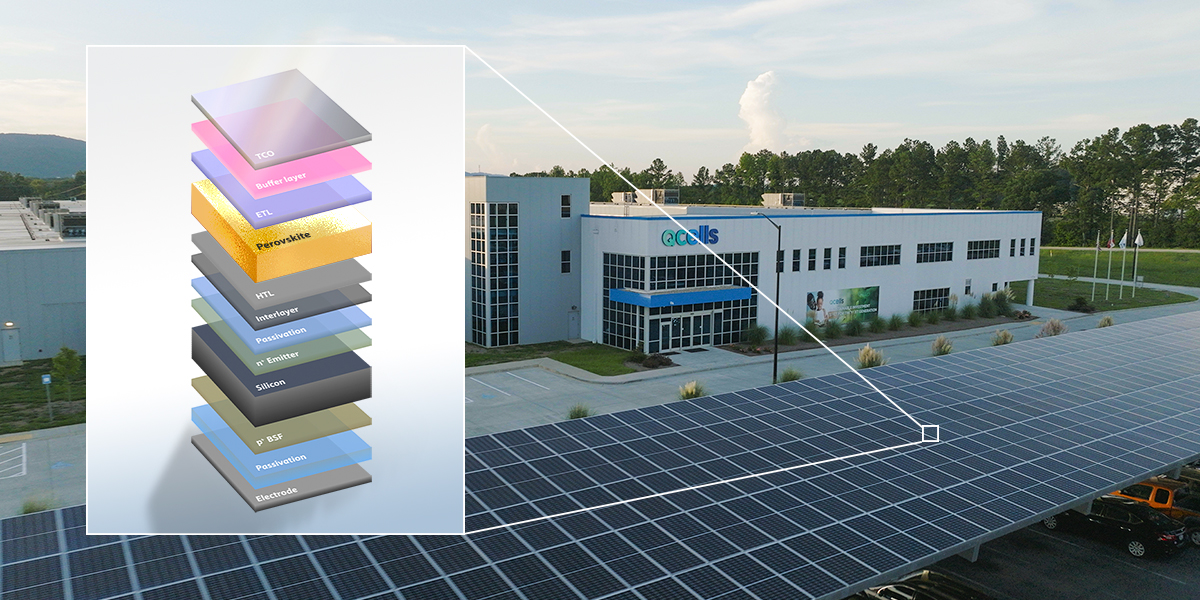5 Technologies That Will Shape Innovation in 2023

The stage is set for 2023 to be a year of revolutionary change in the fast-paced technological landscape. And with mounting geopolitical tensions and an increasing number of unprecedented climate crises, these innovations can’t come soon enough.
The unique backdrop of challenges in this new year presents a significant opportunity to create technology that will stand in the gap, meeting today’s obstacles with tomorrow’s solutions. From great advancements in green energy to digital finance solutions at our fingertips, climate monitoring at a cosmic level and more, 2023 is shaping up to be a critical inflection point in the global technology timeline.
Hanwha is leveraging the confluence of eco-friendly businesses and next-generation technology to build a more optimistic future. Here’s how five of these emerging technologies are creating a new wave of sustainable solutions for communities in every corner of the globe.
1. Perovskite: Turbocharging the Solar Industry

Though the transition to green energy has made great progress in recent years, annual renewable growth will need to double compared to the IEA’s five-year forecast to achieve the 2050 net-zero emissions goals outlined in the Paris Agreement. Hanwha is hard at work to steer these efforts. The company has announced its participation in an EU-funded R&D project, PEPPERONI, which is aimed at mass-producing next-generation solar cells called tandem cells.
Currently, more than 90% of the global solar market is comprised of monocrystalline cells made with polysilicon. However, research has shown that solar modules can become even more efficient when an adaptable photovoltaic material, perovskite, is added into the mix. This compound has a crystal structure which can be adapted to absorb parts of the light spectrum that typically can’t be used by monocrystalline cells. When layered on top of silicon, the two materials work in tandem to boost cell efficiency, resulting in solar panels that have the potential for higher power conversion efficiency (PCE). Perovskite’s unique structure also makes it a lightweight and flexible material that can easily be deposited onto most surfaces.
The increased efficiency and overall benefits of these so-called tandem cells makes them an important component in the broader green energy transition. Accordingly, PEPPERONI has placed its focus on establishing a tandem cell pilot line at the Hanwha Qcells Global R&D Center in Thalheim, Germany, with plans to mass produce the cells after June 2026. By promoting the wider adoption of more efficient clean energy solutions, Hanwha is shifting the global energy mix.
2. H2GT: Fueling the Energy Transition

Hanwha Power Systems Gas Turbine for Hydrogen Combustion
What is hydrogen? As a hot topic in the energy sphere, the power source continues to gain attention for its potential to be the sustainable fuel of tomorrow, and for good reason. Hydrogen can be burned as a fuel with near-zero carbon emissions, making it an attractive energy source across multiple sectors.
While a full hydrogen transition is still in the works, Hanwha is advancing its applications through efforts to convert existing gas turbines into mixed combustion systems. With its “hydrogen to gas turbine technology,” or H2GT, Hanwha is able to retrofit existing LNG-fired power plant gas turbines to run on up to 65% hydrogen fuel by volume — a crucial intermediary step between current technology and the full-scale use of green energy, including green hydrogen. Thomassen Energy, a Dutch subsidiary of Hanwha Power Systems, will apply their co-firing expertise to a 123-megawatt gas turbine in Rotterdam. The hybrid solution will allow the turbine to burn over 30% hydrogen along with natural gas to create electricity for some 15,000 homes.
Co-firing turbine technology doesn’t come without challenges, particularly nitrogen oxide (NOx) emissions and the risk of flashback, which can occur when rapid combustion speeds cause flames to propagate up towards the incoming fuel nozzle. Hanwha is already implementing solutions that address these issues including revolutionary technologies such as FlameSheet™, a combustion system operated by Hanwha Power Systems. When installed on retrofitted gas turbines, the FlameSheet lowers the risk of flashback while significantly reducing NOx emissions, creating a win/win benefit for mixed combustion systems.
With H2GT technology at the helm, Hanwha is growing utility-scale hydrogen-to-power projects and ushering in an entirely new era of safe, stable solutions for the green energy transition.
3. Agricultural Biotechnology: The Future of Food

Climate change has had a heavy impact on the agricultural sector as increasing global temperatures continue to drive more extreme and damaging weather events. Droughts, floods, heat waves and unpredictable rainfall brought on by global warming all pose major threats to agricultural production and food security.
Agricultural biotechnology aims to alleviate these effects by boosting crop resilience. But what is biotechnology? Simply put, biotechnology is any technology that utilizes biological systems or living organisms to create a different product. By tapping into biotechnology, including genetic engineering, crops can be designed to tolerate periods of drought, produce higher yields and resist specific plant diseases and pests, all of which are vital to minimizing crop loss while helping farmers keep up with food demand. Bioengineered crops can better withstand environmental instability and provide growing yields, allowing farmers to maintain their livelihoods and feed expanding populations in the face of a changing climate.
Hanwha’s investments are putting biotechnology to work unlocking new realms of possibility within our global food system. Hanwha Impact recently backed Inari Agriculture, an AgTech firm utilizing gene-editing technology and artificial intelligence (AI) to develop Earth-friendly corn, soybean and wheat seeds that increase yield all while using 40% less water and fertilizer than traditional farming methods. Though small in size, these smart seeds have the potential to make a big impact on the environment as well as the communities they will feed. Through its investment, Hanwha is cultivating sustainable progress that will yield more bountiful days ahead.
4. Digital Finance: Expanding the Financial Landscape

The world is currently experiencing a digital upheaval unlike any other. The rapid, disruptive technological advancements underscored by digital transformation are, and will continue to, permanently shift all areas of the financial sphere. To successfully navigate this dynamic landscape, companies will need to adopt a position of agility and innovation.
With a robust ecosystem of financial solutions, Hanwha is making significant contributions to the fintech shift. The company is constantly exploring and implementing new ways to boost customer experience with improved convenience and efficiency. For example, the process of trading stocks can be expensive and complex, requiring consumers to pay high fees to banks or securities firms. Hanwha Asset Management’s PINE app and Hanwha Investment & Securities subsidiary Pinetree Securities’ PineX app both offer retail investors an easy way to trade securities directly. Hanwha Life’s LIME app also capitalizes on convenience and offers its customers easy access to insurance services in addition to fun and interesting lifestyle content. In this way, customers the world over have access to convenient, fee-free securities trading at their fingertips.
Digital transformation and next-level security solutions go hand-in-hand. As the digital reach continues to become more commonplace in our everyday lives, it is crucial for security measures to keep up with the curve in order to keep customers safe. Pinetree Securities has made the process of opening an account on their app both safe and convenient by applying e-KYC (electronic Know-Your-Customer) technology. Not only does this feature allow customers to open an account within a day, it also utilizes biometric face-matching, real person verification and optical character recognition (OCR) to securely verify customer identities.
By fully embracing the opportunities for growth created by this era of digital transformation, Hanwha is heading into 2023 with products that turn the complicated financial services of old into streamlined solutions building brighter days ahead.
5. Earth Observation Satellites: Taking Climate Tech to New Heights

The Earth experienced another year of climate extremes in 2022 with many new high temperature records and an increasing concentration of greenhouse gases. Europe experienced the hottest summer on record, and globally, 2022 was the fifth-warmest year ever recorded, further underscoring the very real and present effects of global warming. As these impacts continue to affect our daily lives, the need for technologies that can help us understand and mitigate them becomes increasingly urgent.
Earth observation (EO) satellites are one such powerful tool in identifying what causes global warming and extreme weather trends. They provide essential information and data on a wide variety of factors including ice thickness, ocean salinity and air quality, which can be crucial indicators for impending weather events. Satrec Initiative, a satellite maker founded in 1999 in which Hanwha Aerospace is the largest shareholder, is an EO service provider. In addition to valuable environmental monitoring, its satellites can be used for a wide range of services such as mapping, disaster monitoring, land use planning, urban development, agriculture and weather forecasting.

Today’s Technology, Tomorrow’s Transformation
The current challenges facing the world today cannot be solved overnight. But thanks to boundless innovation and courageous climate action, we can be sure that the positive impact of these emerging technologies will be realized in 2023 and far beyond.
Outfitted with pioneering solutions and driven by sustainability, Hanwha will never cease to take bold action for Earth, for society and for a greener tomorrow.
Get the latest news about Hanwha, right in your inbox.
Fields marked with * are mandatory.
- Non-employee
- Employee









